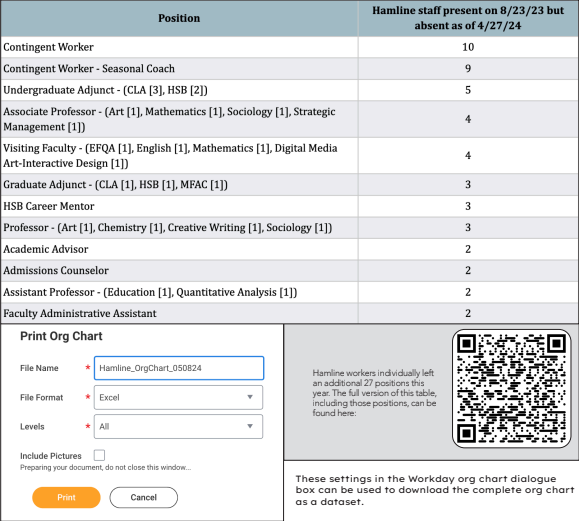Students and faculty alike have highlighted the loss of some familiar faces around campus throughout this year. As some have expressed that information at Hamline is often siloed into separate departments and offices, it is not easy to have an objective, institution-wide view of the changing workforce at Hamline. Through repeated visits to Workday, the answers to questions about which and how many university employees have recently left are available to the Hamline community, but they may be hard to find.
Since 2020, Hamline has used the platform Workday to deliver its registration, human resources and financial services. Despite Workday’s expansive capabilities, people of all ages and levels of responsibility on campus have sometimes struggled to make sense of it.
Deep in Workday’s menus, information can be both technically available and practically inaccessible. Though Hamline does not publicly post its full organizational chart (“org chart”), any member of the Hamline community with a Workday login can visit the platform to see where precisely they fit in the school’s official hierarchy.
If that visitor tries to “print” the Workday org chart, the print settings include an option to save all levels of the org chart as a Microsoft Excel spreadsheet. The resulting file contains a tiered list of every current employee including all members of the administration, faculty and staff as well as student workers. That snapshot offers a lot of information, but by repeating the process on a later date, they would also receive a new, updated list that is missing any workers who left in the meantime and which includes all new employees.
By returning to this process periodically throughout the 2023-24 academic year, The Oracle was able to track personnel changes on campus in some detail.
“There’s this internalized anxiety about ‘What’s good sharing of information?’ And that is weird to me always,” professor of English Mike Reynolds said. “Why aren’t we talking about how many people might have left? Yes, it’s frustrating. Yes, it’s concerning. But why wouldn’t we talk about it?”

Most of the changes in personnel were student workers. While student work covers many essential roles around campus, and cuts to Hamline Work Study have made the university a less stable employer for many student workers, we expect the number of student workers to fluctuate widely under normal conditions as students graduate, transfer or find other work off campus. On the scale of months and years, we expect student workers to be temporary.
Which positions are permanent? By focusing on Hamline’s non-student employees, we see again that there was less job stability over the course of the academic year for a few classes of workers with short-term contracts: contingent workers and adjunct faculty. The list also features a few longer-term roles: visiting, tenure-track and even tenured professors.
Chair and professor of creative writing, Richard Pelster-Wiebe, has seen four full-time faculty leave his department in recent years.
“We don’t have enough faculty to staff our classes,” Pelster-Wiebe said. “In fact, we have — it’s either 19 or 20 — classes that must be staffed by adjuncts. That’s extreme.”
Although this information is available to Workday-connected members of the Hamline community, to preserve individual privacy, The Oracle has decided to anonymize the data shown here. However, by going through the process of periodically downloading the Workday Org Chart and identifying the names and job titles that have changed, a complete, up-to-date version can be gathered at any time.







